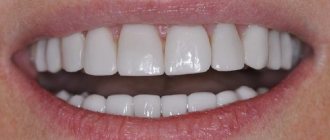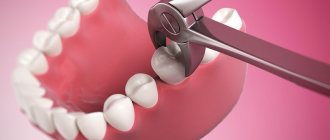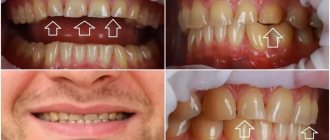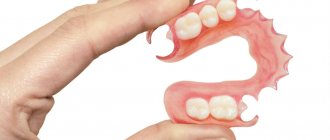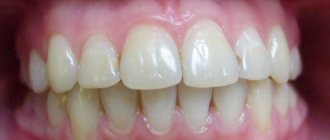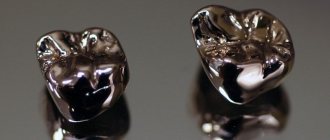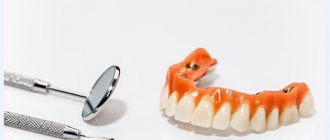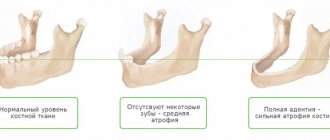Due to the rhythm of modern life, a corresponding imprint is left on a person’s health and appearance. One of the important factors of good health is strong and healthy teeth. But, unfortunately, not many can boast of this.
The product allows you to correct aesthetic imperfections
Special attention in dentistry is paid to dental prosthetics, especially if they are anterior and the aesthetic appearance depends on them. Plastic teeth have many advantages over others, but they are not suitable for everyone.
Peculiarities
The main difference between plastic teeth and others is their rapid production. Many are of the opinion that it is not worth using such a design, since there are a large number of shortcomings. In fact, the advantages outweigh almost all the disadvantages.
An example of what crowns look like
You can talk about the feasibility of plastic teeth after studying the characteristics of the structures:
- Not strong enough. Compared to ceramics, the product is less durable, which is why they are not installed on chewing teeth.
- The service life of the product depends on the strength of the material. Since plastic does not have sufficient strength, orthopedic structures made from it cannot last long.
- The finished product has a porous structure, due to the properties of the material.
Plastic teeth are most often installed by those who cannot afford something more expensive and of higher quality.
Advantages of plastic crowns
- Low cost compared to other materials
- Fast production and installation time (such a crown is made practically in the patient’s mouth and is installed literally in one day)
- Protects the prepared tooth from negative influences
- Allows the tooth to function normally and participate in the process of chewing food (although it is better to exclude solid foods from the diet)
- Preserves the beauty of your smile (the crown looks like a real tooth)
When choosing one type of crown or another, everyone takes into account their financial capabilities, as well as the functional purpose of the prosthesis. If you need a permanent structure, it is better to choose more durable materials, but if it is temporary, then plastic dental crowns But, like all types of prostheses, they also have their drawbacks.
Varieties
Temporary crowns
It is possible to talk about specific types of construction only if they are linked to a specific factor.
You can include it here:
- Material. Today, two types of material are used - hot and cold curing. The choice of a specific type influences further manufacturing features.
- Execution principle. In this case, there are two varieties - cast plastic crowns and pressed ones. Pressed ones are significantly inferior to cast ones, and this concerns not only strength. They look more aesthetically pleasing.
- Functionality. In this case, there are also two types – permanent and temporary. Permanent ones are used to create convenience for the patient, for example, if the implantation of front teeth takes a long time.
Additional elements can complicate the production process; accordingly, the cost will also be an order of magnitude higher.
Indications for installation
An example of how a crown is made
Not everyone can install crowns of this type.
There are certain indications that are important to consider before prosthetics:
- there are minor defects on the frontal group of teeth;
- the color of the enamel has changed - the problem cannot be solved by other methods;
- protecting the tooth from external factors, for example, during the interval between turning and prosthetics;
- closure of implants, temporary plastic structures;
- The front row of teeth is damaged, it is necessary to restore diction.
Plastic teeth can be installed to improve the aesthetic appearance. You can find out about other indications from your doctor.
Contraindications
One of the contraindications for installation is teeth grinding.
Despite the advantages of the products, in addition to the indications for installation, there are also contraindications, among them are:
- it is forbidden to install in childhood, until the permanent bite is formed;
- bruxism - clenching of teeth, strong grinding of them;
- mental abnormalities in the patient;
- failure to comply with personal hygiene rules, resulting in the accumulation of a large amount of plaque;
- there is a strong inflammatory process in the place where prosthetics is planned.
You cannot install plastic teeth if the patient is allergic to metal, as well as to other components included in its composition. In each of these cases, it is recommended to use other prosthetic materials, for example, ceramics.
Disadvantages and advantages of plastic crowns
Disadvantages of crowns
The main disadvantages of plastic crowns are:
- fragility (plastic dentures can last about 2 years, while ceramic and metal crowns can last at least 10 years);
- the ability of the porous structure of plastic to absorb odors and dyes;
- gradual cracking of the walls of the crown and the formation of chips on its surface;
- the presence in plastic of substances that can provoke the development of allergic reactions;
- low hygienic qualities (pores in plastic are an excellent “shelter” for the reproduction and growth of pathogenic microorganisms);
- the need for pronounced grinding of the supporting teeth (only plastic crowns with much thicker walls than prostheses made of metal or ceramic can maintain sufficient strength);
- high risk of mechanical injury to gum tissue from the edges of plastic crowns.
Advantages of crowns
In turn, the advantages of plastic crowns include:
- comparative simplicity and high speed of production, no need to use complex equipment;
- excellent aesthetic qualities, absence of unnatural shine characteristic of metal crowns;
- low cost (the price of plastic prostheses can be tens of times lower than for metal or ceramic prosthetic structures).
Despite the huge number of disadvantages of plastic, prostheses made on its basis are actively used for orthopedic treatment of dental pathologies.
Advantages and disadvantages
The product can withstand a certain load
Plastic crowns have many advantages compared to other products.
Among them:
- Minimum time for production. Just a few days are enough for the patient to receive a complete dental restoration.
- There is no need for expensive equipment. The master’s technique is simplified, the entire manufacturing process costs an order of magnitude less.
- Aesthetic properties. Despite the fact that the cost of the material is not high, it looks beautiful. Externally, the product resembles natural enamel. Good specialists can achieve a shade color that is as close as possible to your own enamel.
- Lightness of the material. It can be used when there are restrictions on the load.
Plastic is malleable, so any shape can be made. In case of chips or minor defects during operation, the product must be repaired.
Flaws
Teeth need preliminary grinding
Advantages are replaced by disadvantages, there are few of them, but they are there:
- short service life - no more than three years;
- low strength - under increased load, cracks or other defects appear;
- the patient may experience an allergic reaction to acrylic polymers;
- The surface is microporous, which makes hygiene difficult.
If you eat food that contains dyes, you may experience that the color of the structure will change. There is a high probability that the plastic will be separated from the mounting structure.
Advantages and disadvantages of dental plastic crowns – expert opinions of doctors
The advantages of plastic construction include the following points:
- the simplest restoration of tooth function;
- relatively low price for “new teeth”;
- aesthetics of the product, because installing such a crown is always better than leaving a gap in the cavity;
- the ability to choose the required crown based on the shade and shape of the tooth;
- they are quickly produced (even in front of the patient).
The nuances of using temporary plastic crowns include:
- short service life - from several months to a year;
- fragility of the material, especially when taking solid products;
- crowns are not as transparent as ceramic ones;
- Over time, such artificial teeth darken and absorb pigments, because plastic has a porous texture;
- over time, a gap forms between the lined part and the frame, where bacteria accumulate;
- The plastic material wears out quickly;
- the edges of the crown may put pressure on the gums, and additional soft tissue treatment may be necessary;
- abutment teeth can be pre-ground;
- plastic can cause allergies.
Manufacturing process
There are two ways to manufacture a structure - direct and laboratory. Each of them will be discussed in more detail below.
The product is made from the obtained casts
Direct method
Used when it is necessary to install a non-permanent structure. It doesn't take much time to make. The mass is applied and an impression is taken from the desired tooth. In order for the future crown to be put on, the teeth are ground down.
Once the impression is ready, it is filled with plastic and can be put on immediately. The doctor waits until the mass hardens, and then takes an impression. Everything in the patient’s mouth is ground and sharpened.
Laboratory method
It is necessary to make a special model
The method is divided into several stages:
- An impression is taken using silicone masses;
- a plaster model is made based on the impression obtained;
- plastic is poured into finished models;
- the structure is freed from plaster, after which everything is turned and polished.
There are many nuances in the manufacturing process that are known only to dentists.
Installation method
Before performing prosthetics, the oral cavity is sanitized. After the impression is taken, the model is sent to the laboratory for further work. The dentist grinds down the teeth on which the product will be placed.
After prosthetics, aesthetics are restored
Interesting! Depulpation is carried out - the pulp and nerves are removed, all canals are filled.
The next stage is fitting. If there are minor defects, they will be corrected mechanically - by grinding and so on. The product is fixed only after the doctor understands that it is completely suitable and the patient does not experience discomfort. Cement is used for fixation.
Price
The main factor in choosing a particular material is cost. That is why prices for plastic products need to be discussed separately. On average, plastic teeth cost up to four thousand. Based on this figure, we can conclude that orthopedic structures are the most affordable, and this is the main advantage.
The cost may not always be the same; many factors can influence it. First of all, this concerns the types of crowns. For example, temporary crowns made directly in the doctor’s office cost 30% less.
Model of teeth in articulator
There are reinforced structures, their cost is up to five thousand rubles. In addition, the work of the attending physician is paid, namely the preparation of the oral cavity for prosthetics. Sanitation will cost five hundred rubles, but maybe a little more, depending on how complex the problem is.
Cost of a plastic crown
The final cost of making a plastic crown depends on the following factors:
- type of material;
- method of manufacturing the structure;
- appointment of the necessary crown (temporary or permanent);
- condition of the oral cavity and the need for treatment;
- features of the teeth that provide support for the crown;
- qualifications of the serving dentist;
- clinic pricing policy.
The cost of a simple temporary plastic crown per tooth is up to 1000 rubles. If it is made by a technician, the cost can reach 2,500 rubles per tooth. The manufacture of a permanent plastic structure will cost the patient 4,500 rubles per unit.
At Zuub dentistry you will be offered the best prices for plastic crowns. Make an initial appointment with a dentist to find out the cost of manufacturing the required crown in the laboratory and turnkey plastic prosthetic services.
How does the withdrawal proceed?
The warranty period is up to three years. After this time, the structure must be dismantled. Sawing can be used to remove crowns, but due to the thinness of the plastic, this may not be necessary.
The withdrawal process is as follows:
- The structure is exposed to ultrasound. The properties of hardened cement will become much weaker.
- A Kopp apparatus is used. With pushing movements, the crown is tightened, but the tooth itself remains undamaged. This procedure does not cause pain; anesthesia is given at will.
- After the crown is removed, the teeth are processed. The remaining cement is removed and preparations are made for re-prosthetics.
After installing dentures, you should visit the dentist once every six months.
Many people are faced with the need for prosthetics, but do not know which design is best to choose. As you can see, plastic products are good in their own way, but the final choice should be made not only by the patient, but also by his doctor.
Additional questions for your doctor
Whitening dentures
Is it possible to somehow whiten dentures made of plastic?
After the prosthesis is installed, the patient will be given recommendations on how to care for it. Most often these are familiar hygiene procedures.
However, such methods will only slow down the darkening process; in addition, special pastes should be used. The oral cavity can be periodically rinsed with medicinal plants, thus the development of the inflammatory process can be avoided.
Darkening of the structure
Can plastic teeth darken?
Despite the fact that the surface is thoroughly polished, some roughness may remain. Thus, various deposits, food particles, etc. can linger and accumulate. Over time, plaque will form, the dentures will begin to darken, and the original appearance will be lost.

